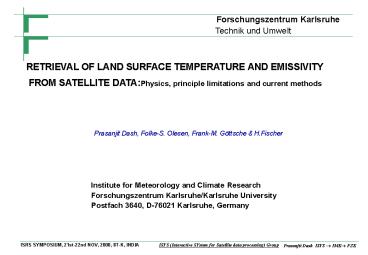Doctoral presentation Number 1 PowerPoint PPT Presentation
1 / 12
Title: Doctoral presentation Number 1
1
RETRIEVAL OF LAND SURFACE TEMPERATURE AND
EMISSIVITY FROM SATELLITE DATAPhysics,
principle limitations and current methods
Prasanjit Dash, Folke-S. Olesen, Frank-M.
Göttsche H.Fischer
Institute for Meteorology and Climate Research
Forschungszentrum Karlsruhe/Karlsruhe
University Postfach 3640, D-76021 Karlsruhe,
Germany
2
THIS SLIDE NOT REALLY TO BE SHOWN just the
abstract of the corresponding article
3
- Land Surface Temperature (LST)
- Physics
- Theoretical principle
- Suitable part of the electromagnetic spectrum
- Radiation measurement from satellites and
radiative transfer equation - Methods of atmospheric correction for known
surface emissivity - Single channel method
- Split Window Techniques (SWTs)
- Multi-angle method
- Effect of emissivity and different methods of
emissivity estimation - Theoretical principle of emissivity calculation
- Determination of emissivity from IR-data
- Normalized Emissivity Method (NEM)
- Thermal Infrared Spectral Indices (TISI)
- Spectral ratio method
- Normalized Difference Vegetation Index (NDVI)
- Classification-based emissivity
- Temperature Emissivity Separation (TES)
4
Land Surface Temperature (LST)
LST ? Temperature measured at the surface ? Skin
temperature of the ground
Determined by the radiation emitted by the whole
target
By thermometer that is in contact with a small
area of the target
RS LST is defined as the average surface
temperature, weighted by their fractional cover
of the surface types in each pixel (Kerr et al.
1992).
Climate Change Detection
?
Numerical Weather Prediction
Global Ocean Circulation
Earth Radiation Budget Experiment
Desertification Monitoring
5
Physics
Theoretical principle
- Total radiative energy emitted by any surface is
directly proportional to its temperature.
- The signal received by sensors is
electromagnetic radiation, which can be
quantified.
Fundamental radiation unit of satellite
meteorology Monochromatic Radiance (R) W m-2 Sr-1
Solid angle in Sr d?
Detector size in m2 dA
Radiant flux in Watts ?
- Independent of path length between surface and
sensor
Assumptions
(1) The atmosphere is in local thermodynamic
equilibrium, which is a good assumption up to
about 100 km. (2) No scattering occurs, which
means only cloud free conditions are
considered (3) Earths surface is a Lambertian
reflector.
6
Physics
Suitable part of electromagnetic spectrum
Optimal part of ems ? 10 ?m and 3.8 ?m
7
Physics
Radiation measurement from satellites and
radiative transfer equation
Surface
TOA
Atmosphere along the upward path
Atmosphere along the downward path, reflected
by surface attenuated along the upward path
GROUND
After integration with the normalised response
function for a given channel
For a spectral emissivity approaches unity, it
approaches zero
8
Mathematical limitation
The problem of Under-determination
The missing equation concept
TOA radiance from satellite sensors
Mathematicallyunderdetermined
9
Methods of atmospheric correction for known
surface emissivity
Single channel method
- Single channel explicitly using the RTE
- Vertical horizontal distribution of T
humidity RH (TOVS, NWP models, radiosonde)
- Basic principle Simulate satellite-measurements
(TOA), by RTM (e.g. MODTRAN) over a range of LST,
? and elevations for the each of the current
atmospheric profiles FORWARD MODELLING
- LST is estimated by interpolating the known
relationships and by interpolating results from
neighboring atmospheric profiles
- For densely vegetated areas, assumption of
constant emissivity of 0.975 ? 0.025 LST
deviation of about ? 0.3 K
- For highly variable surfaces emissivity must be
given as an input parameter
Modeled LST for a part of Europe (Source
Schädlich et al., 1999) (Meteosat IR ECMWF)
10
Methods of atmospheric correction for known SE
Split Window Techniques for LST
- For IR range
- Observations at 2 different ?s in an atmospheric
windowEliminate the influence of TA and solve
for Ts
- Coefficients depend on sensor
AVHRR (NOAA14) A 2.08, B5.54
- Similar weighting functions gt TAsimilar
Assumptions
- in ? is due to in the absorption coefficient
of the gases, WV most imp.
11
Methods of atmospheric correction for known
surface emissivity
Split Window Techniques
PRICE, 1984
BECKER AND Li, 1990
SOBRINO et al., 1991
KERR et al., 1992
COLL et al., 1994
BECKER AND Li, 1995
similar as earlier (1990) but parameterized in
terms of W
12
Atmospheric chemistry (CH4 O3 CO2)
LAND SURFACE TEMPERATURE (LST)

